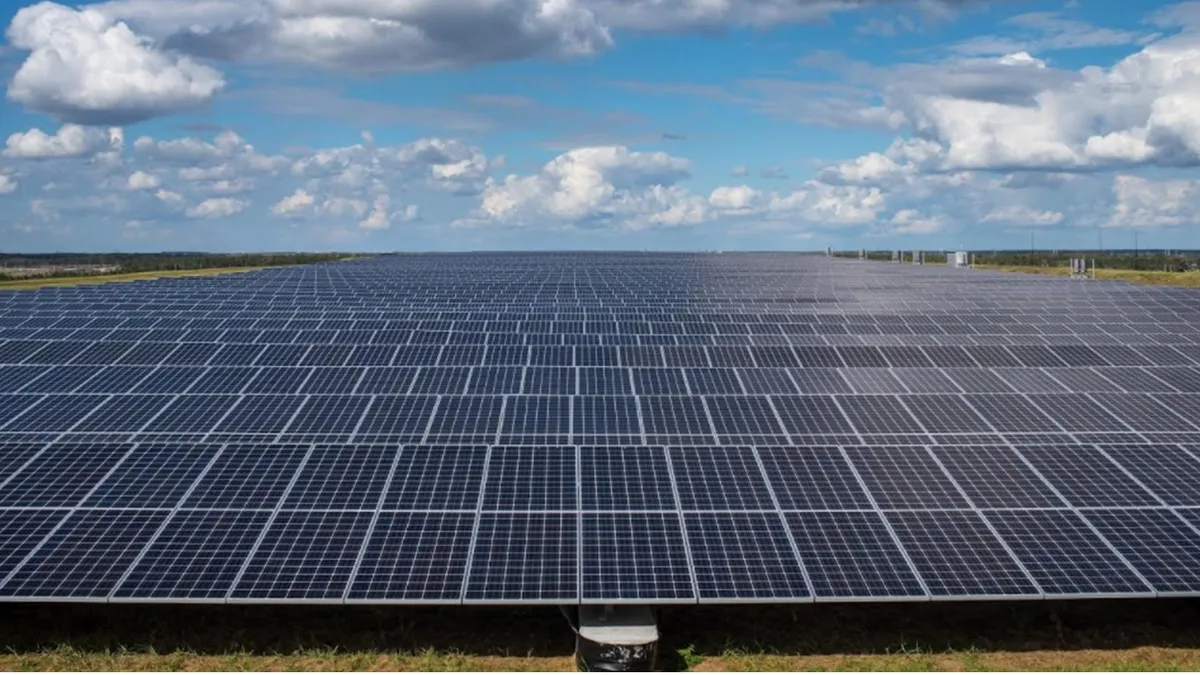New England clouds can't keep the power of the sun from Massachusetts — but stalled interconnection queues and land use concerns are giving developers pause, according to panelists at this year's Solar and Storage Northeast conference in Boston.
Massachusetts in 2018 launched its Solar Massachusetts Renewable Target (SMART) Program — with incentives intended to spur an additional 1.6 GW of solar by 2020. The state quickly exceeded that goal and currently has 2.5 GW of solar installed, with almost 1 GW in the interconnection queue.
But in 2019, Massachusetts' solar industry hit a rut — new installations fell 50% and the sector's workforce shrank by 30%, according to a September Vote Solar report. Meanwhile, rural opposition led to tensions among developers, municipalities and some conservationists, and some towns considered or put in place temporary solar bans.
Now, faced with the potential loss of billions of dollars in potential ratepayer savings as well as thousands of jobs, developers and regulators are working to combat delays and avoid sparking further local opposition.
A congested system
When SMART officially launched two years after its initial announcement in 2016, the state's Department of Energy Resources saw 2,500 applications for solar installations in the first week. Two weeks in, there were enough applications for 600 MW of solar, according to Vote Solar.
Following the swell of interest, National Grid launched a "cluster study," based on ISO New England transmission requirements, intended to look at proposed distributed generation interconnections across its Massachusetts service territory and their impact on the regional transmission system. Developers at the conference in Boston largely blamed that study for the state's current congestion issues.
The study looked at projects over 1 MW to determine collectively how they might impact the transmission grid. 900 MW of solar were stalled as a result of this process — many of them under construction or well into their development, Senior Vice President of Corporate Development at Nexamp John Murphy said. Around 500 MW are still "awaiting the results of further studies" through April, he said.
"I think you really can't overstate how potentially devastating that could have been and still could be to the growth of the industry," he said. "It's a major, major concern for us in terms of how we're going to achieve more growth in the future."
Regulators in September launched an investigation into National Grid, still ongoing, for its interconnection process in central and western Massachusetts, among other issues.
National Grid argued the study was done to streamline the permitting process due to such a large volume of interconnection requests.
"National Grid is proud to have contributed to the impressive solar industry growth across the Commonwealth by interconnecting more solar in our Massachusetts service territory than the rest of New England combined," utility spokesperson Kevin O’Shea told Utility Dive in an email.
"To date, we have connected more than 1.3 GW of customer-owned solar to the grid and are proud of our role as a major contributor to making Massachusetts No. 8 in the country in installed solar capacity. ... In partnership with the Massachusetts DPU and ISO-NE, we are actively completing mandatory assessments of the impact of [distributed generation] projects on the grid and have found innovative solutions to avoid or minimize the delays of proposed projects," he wrote.
But other factors are also potentially crippling to the Massachusetts' industry and its customers, including the state's net metering cap and what compensation prices will look like for developers.
"What's potentially even more disruptive is to not know the value, the cash flow, that new revenue stream that we're going to get for these projects," Manager of Project Development Strategy at Sunpower Corporation Becky Gallagher said at the conference.
SMART brought developers like Sunpower Corporation into the state three years ago and "every single project in our pipeline depends on those answers," she said.
'SMART 1.1'
As a response to some of these issues, regulators and legislators have been working quickly to push through solutions.
Regulators in the fall began collecting comments on SMART with the intention of rolling out an updated version of the program by the end of 2019. But the process was more complicated in the Department of Energy Resources (DOER) than regulators anticipated, according to DOER's Renewable Division Director Eric Steltzer, leading to the delay.
He said the revamped program should be coming out "soon," likely in the form of emergency regulations, meaning they will go into effect immediately and remain in effect for just three months.
"There's a lot of layers to the process, and if it was all up to me, it'd be a different story," he said. "But we are working as expeditiously as we can to get this out."
Within those deliberations, DOER is considering compensation rates, diversity of projects and expanding the low-income definition to include environmental justice communities.
"Sometimes it's being referred to as 'SMART 1' and 'SMART 2,' or '1' versus '2.0'," Steltzer said. But, "it really is a SMART 1.1. It's the next iteration. It's the next version of it. It's not a new program."
Developers are also eyeing the Massachusetts legislature for the passage of H 2866, which would remove the net metering cap for all behind-the-meter solar.
Gallagher said her company is hopeful the legislation will combine with the Senate's energy and climate bills, though it faces resistance from National Grid, which has already hit its solar cap. The utility said it believes the issue of net metering should be resolved through regulation, not legislation.
"While we support efforts to expand solar in Massachusetts, this issue is currently under consideration by the DOER as part of their next phase of the SMART program," spokesperson Christine Milligan told Utility Dive in an email. "We believe that the issue is best resolved by the DOER, taking into consideration the multiple stakeholders involved and the potential impact on rates for our non-solar customers."
Land use
Developers in Boston have also faced fierce opposition in some localities over land use — an issue that will only become more urgent in Massachusetts and across the country, developers noted during the panel.
Towns in Western Massachusetts have been particularly resistant to the trend. Several towns established or considered establishing a moratorium on ground-mounted solar installments in response to local resistance, and DOER made efforts in October to dissuade developers from using prime forest or agricultural land, and incentivize brownfield development.
Though many advocate for using brownfields, landfills and rooftops to avoid exploiting potentially valuable land, solar developers noted that in saturated markets like Massachusetts, most of those sites have already been picked over.
"It's not that the hundreds of developers that work in Massachusetts have somehow missed those areas," Vice President of Policy and Strategy at Borrego Solar Systems Ilan Gutherz said in Boston.
Sites that remain undeveloped are that way for a number of reasons including poor interconnection or transmission issues, the size of the site, or some kind of waste or pollution problem the developers can't overcome.
"There are good financial and economic reasons why those areas haven't been developed, it's not for a lack of trying," said Gutherz.
That makes a hand-in-hand approach with conservationists even more important, said Maine Audubon Conservation Biologist and GIS Manager Sarah Haggerty at the conference.
"We don't want to see moratoriums coming to towns on solar because they don't know how to handle solar," said Haggerty.
If Massachusetts were to reach 25 GW by 2050 — half of what New England as a whole needs to reduce the region's carbon emissions 80% below 1990 levels by 2050, according to Brattle — it needs to think about those goals in harmony with forest conservation goals, Senior Director of Development at Massachusetts-based developer BlueWave Solar Drew Pierson said in Boston.
Massachusetts Audubon society wants to have 2.5 million of the state's 3.2 million acres of forest preserved by 2050 — that leaves a "budget" of around 672,000 acres open for development, according to Pierson, though the majority of that will likely go to real estate, not solar development.
Ultimately, Pierson estimates developers could take down just 2.2% of total forests in Massachusetts, not taking into account the assumption that future solar panels will be more efficient and ultimately take up less space.
Part of that development should consider what trees produce the most ecological value, said Haggerty. When looking at forests and open spaces, you also can't assume that all those spaces are equal in their ecological or agricultural benefits, developers noted, and that's another area where regulators, conservationists and developers should be able to work together.
"I think that if we can acknowledge first that we are cutting [trees], that is an impact, not to discount it, I think it makes people feel heard," said Pierson. "And then once people do feel heard, how can we look at any variety of mitigation measures that are achievable and have some buy in."
Pollinator-friendly solar, agro-voltaics and other dual-purpose site development strategies can all help with developer-town relationships, said Pierson.
Several Midwestern states and utilities have cemented these strategies into policy. Xcel Minnesota in 2018 began to require vegetation disclosures as part of its solar request for proposal process, and Michigan Gov. Gretchen Whitmer, D, in 2019 announced an executive decision to open up farmland to solar development, as long as it meets certain vegetation requirements.
"We take a long-term view because the towns that we developed in five years ago and we made mistakes in, we have to develop in now and we have to develop in two years from now. We have to be back in front of those same boards who had a moratorium two years ago," said Pierson.
This post has been updated to clarify National Grid launched its study based on grid operator transmission requirements.























